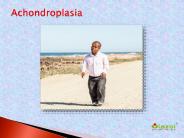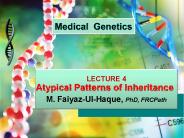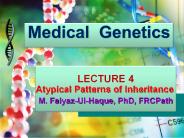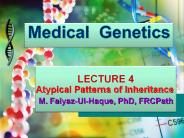Achondroplasia PowerPoint PPT Presentations
All Time
Recommended
It is caused by a mutation of the fibroblast growth factor receptor-3 (FGFR3) gene on ... Lumbar laminectomy surgery. Limb lengthening surgery is very controversial: ...
| PowerPoint PPT presentation | free to download
Achondroplasia Kelly Boylan and Nicole Roberti Definition Achondroplasia is a disorder of bone growth. Although achondroplasia literally means
| PowerPoint PPT presentation | free to view
Achondroplasia By: Tyler Denney, Avery Falick, Valerie Finstad, Matt Lien Type of Genetic Disorder Achondroplasia is an autosomal dominant genetic disorder.
| PowerPoint PPT presentation | free to view
Achondroplasia is a bone disease which affects about 1 in every 10,000 infants. This disease is caused by a mutation in the FGFR3 gene that impairs the growth of bone in the limbs and causes abnormal growth in the spine and skull.
| PowerPoint PPT presentation | free to download
Achondroplasia is a bone disease which affects about 1 in every 10,000 infants. This disease is caused by a mutation in the FGFR3 gene that impairs the growth of bone in the limbs and causes abnormal growth in the spine and skull.
| PowerPoint PPT presentation | free to download
Affects about 1 in 25,000 people. ... nonproportional dwarfism. shortening of the proximal limbs (called rhizomelic shortening) ...
| PowerPoint PPT presentation | free to download
Achondroplasia Dwarfism How to recognize achondroplasia: Long narrow torso, with short extremities Large head with an oversized forehead Fingers shortened ...
| PowerPoint PPT presentation | free to view
Achondroplasia: Dwarfism. Kelly LaBarre. Clinical Features. Achondroplasia ... Presents clinically as a long narrow trunk with short extremities, large head ...
| PowerPoint PPT presentation | free to download
Presented by: Britt Shields and Connor Nash Achondroplasia is the common cause of dwarfism Approximately 1 in every 25,000 have this disorder The average height of a ...
| PowerPoint PPT presentation | free to view
... (males more severely affected)(disproportionate) Turner Syndrome (45,X) (proportionate) Laron Dwarfism Insensitivity to growth hormone (receptor defect) ...
| PowerPoint PPT presentation | free to view
Autosomal dominant- if you have one copy of the mutated gene, ... respiratory problems, clubfeet, hitchhiker's thumb, and ears with a cauliflower appearance ...
| PowerPoint PPT presentation | free to view
Thereafter 2.5' per year until puberty. Final adult height. Mid-parental height 2' for boys and -2' for girls. Short stature ...
| PowerPoint PPT presentation | free to view
: Read here the market research report on the Achondroplasia Treatment Market published by CMI team.
| PowerPoint PPT presentation | free to download
This presentation will cover all aspect of achondroplasia.
| PowerPoint PPT presentation | free to download
Mutations (chemical changes) within a single gene cause achondroplasia. ... Lordosis and/or kyphosis. Hydrocephalus ('water on the brain' ...
| PowerPoint PPT presentation | free to view
Achondroplasia Dwarfism By Noy A. Period 5 What Is Achondroplasia? A bone growth disorder that results in abnormality of cartilage formation A mutation that occurs in ...
| PowerPoint PPT presentation | free to download
Natural History of Achondroplasia Autosomal Dominant Gene Mutation Future Therapies Counteract the overactive FGFR3 effects on endochondral bone formation.
| PowerPoint PPT presentation | free to view
SKELETAL AND SOFT TISSUE DISEASE-BONE Achondroplasia Genetic derangement in epiphyseal cartilaginous growth Retarded endochondral bone formation,
| PowerPoint PPT presentation | free to view
Rotational Profile of the Lower Extremity in Achondroplasia : Computed Tomographic Examination of 25 patients Hae-Ryong Song, M.D., Keny Swapnil.M M.S ,
| PowerPoint PPT presentation | free to view
Title: lcpmri Author: Last modified by: songhae Created Date: 5/2/1997 12:09:41 AM Document presentation format: (4:3)
| PowerPoint PPT presentation | free to view
Endocrine System Dr. Annette M. Parrott GPC BIOL1612 * * * * Disorders of the Endocrine System Cushing s Disease Achondroplasia ...
| PowerPoint PPT presentation | free to download
MUTATIONS in NON-coding sequences defective transcription ... OSTEOGENESIS IMPERFECTA. ACHONDROPLASIA. FAMILIAL HYPERCHOLESTEROLEMIA ...
| PowerPoint PPT presentation | free to view
ACHONDROPLASIA DR. O.KUMARESAN SMCH, CHENNAI ANAESTHETIC MANAGEMENT OF FAMILIAL ACHONDROPLASTIC DWARF This report describes the successful management of a 20 year old ...
| PowerPoint PPT presentation | free to download
Your genes can be compared to your own personal blueprint. ... Achondroplasia (common Dwarfism) Familial (early-onset) Alzheimer Disease. Huntington Disease ...
| PowerPoint PPT presentation | free to view
Ms. Cailotto s Birth Defect Project Down Syndrome Cerebral Palsy Cleft Lip and Palate Cystic Fibrosis Sickle-Cell Achondroplasia (Dwarfism) Tay-Sachs
| PowerPoint PPT presentation | free to download
Mendelian Genetics Principles of Heredity 4. Law of Dominance, cont. c. Some more traits: Polydactyly Syndactyly Achondroplasia 4. Law of Dominance, cont. d.
| PowerPoint PPT presentation | free to view
... will have a child with cystic fibrosis? Show your work. ... Cystic Fibrosis. Sickle Cell. Achondroplasia (dwarfism) Epistasis. One gene can mask another ...
| PowerPoint PPT presentation | free to view
a case in which one allele is not completely dominant over another. ... Osteogenesis Imperfecta. Other Disorders. Achondroplasia autosomal, dwarfism (one form) ...
| PowerPoint PPT presentation | free to view
NORMAL GENES ARE USUALLY DOMINANT OVER ABNORMAL TRAITS. SOMETIMES A DOMINANT GENE CAN ... ACHONDROPLASIA (DWARFISM) HUNTINGTON'S DISEASE. GENOME IMPRITING ...
| PowerPoint PPT presentation | free to view
Turn in HW2 to your TA's folder up front. ... achondroplasia (a sketelal disorder causing dwarfism) X-linked recessive pedigrees ...
| PowerPoint PPT presentation | free to view
LECTURE 5 M. Faiyaz-Ul-Haque, PhD, FRCPath Genetic Counseling
| PowerPoint PPT presentation | free to download
LECTURE 5 M. Faiyaz-Ul-Haque, PhD, FRCPath Genetic Counseling * 5 * Fig 29.4 Punnett square showing the Hardy-Weinberg principle. Lecture Objectives By the end of ...
| PowerPoint PPT presentation | free to download
... easily inherited if both parents have the disorder, but can also ... If both parents have dwarfism, the child has a 50% chance of inheriting the disorder. ...
| PowerPoint PPT presentation | free to view
There are way to many types of Dwarfism for me to go over in this short amount ... Hitchhikers thumb. Ears with a cauliflower appearance. Growth-Hormone Deficiency ...
| PowerPoint PPT presentation | free to view
Global Skeletal Dysplasia Market is set to witness a stable CAGR in the forecast period of 2019- 2026.
| PowerPoint PPT presentation | free to download
Global Skeletal Dysplasia Market is set to witness a stable CAGR in the forecast period of 2019- 2026.
| PowerPoint PPT presentation | free to download
The Human Genome Ch. 14 Human Chromosomes Karyotype = how chromosomes are arranged in pairs Humans have 46 chromosomes or 23 pairs The 23rd pair are the sex ...
| PowerPoint PPT presentation | free to download
Title: Slide 1 Author: SUPERVISOR Last modified by: Supervisor Created Date: 4/10/2005 9:40:51 PM Document presentation format: On-screen Show Company
| PowerPoint PPT presentation | free to view
Title: Author: Last modified by: Created Date: 1/1/1904 1:17:38 PM Document presentation format:
| PowerPoint PPT presentation | free to download
Human Genetics: Genetic Disorders Ms. Y. Martinez LSHS 07-08
| PowerPoint PPT presentation | free to view
How many chromosomes do humans have? Humans have 46 chromosomes. They occur in 23 pairs! Do you remember what this is called? A karyotype Can you remember any of the ...
| PowerPoint PPT presentation | free to download
SPINE DISORDERS Complex structure Spine has to move transmit weight-protect the spinal cord Clinical examination Look-Feel-Move Waddel s signs Disc degeneration ...
| PowerPoint PPT presentation | free to download
Human Genetics: Patterns of Inheritance for Human Traits We will be discussing 5 Patterns of Inheritance for Human Traits 1. Single Allele Dominant 2.
| PowerPoint PPT presentation | free to view
LECTURE 4 M. Faiyaz-Ul-Haque, PhD, FRCPath Atypical Patterns of Inheritance
| PowerPoint PPT presentation | free to download
Mutations and other genetic issues Genetics Unit
| PowerPoint PPT presentation | free to download
Gregor Mendel Pea Plants and Inheritance Patterns
| PowerPoint PPT presentation | free to view
Genetic Disorders AP Biology
| PowerPoint PPT presentation | free to view
GANGGUAN PERTUMBUHAN PADA ANAK Gangguan pertumbuhan Perawakan normal pertumbuhan terganggu Gangguan pertumbuhan Perawakan pendek pertumbuhan normal ETIOLOGI PERAWAKAN ...
| PowerPoint PPT presentation | free to download
Today s Date Here Objective Here!
| PowerPoint PPT presentation | free to download
LECTURE 4 M. Faiyaz-Ul-Haque, PhD, FRCPath Atypical Patterns of Inheritance
| PowerPoint PPT presentation | free to download
LECTURE 4 M. Faiyaz-Ul-Haque, PhD, FRCPath Atypical Patterns of Inheritance
| PowerPoint PPT presentation | free to download
Title: MENDELIAN LAWS OF HEREDITY, MONOHYBRID AND DIHYBRID CROSSES Author: x4 Last modified by: acer Created Date: 2/27/2005 6:30:34 AM Document presentation format
| PowerPoint PPT presentation | free to view
Title: Molecular Pathology Author: user Last modified by: SSC1 Created Date: 11/24/2005 6:32:37 PM Document presentation format: On-screen Show (4:3)
| PowerPoint PPT presentation | free to download
Extensions of Mendelian Genetics Mendelian genetics seems to be relevant to only a small set of heritable features For only a few characters there are
| PowerPoint PPT presentation | free to download
Mendelian Genetics K. Sathasivan Basic genetic terms. Mendel's laws of inheritance. Complexities of genetic expression. Mendelian genetics in Humans
| PowerPoint PPT presentation | free to download
Huntington s Disease Inheritance Pattern Autosomal dominant Description Degenerative neurological disorder Symptoms ... Genetic Disorders Author: CVS Last ...
| PowerPoint PPT presentation | free to view
























































